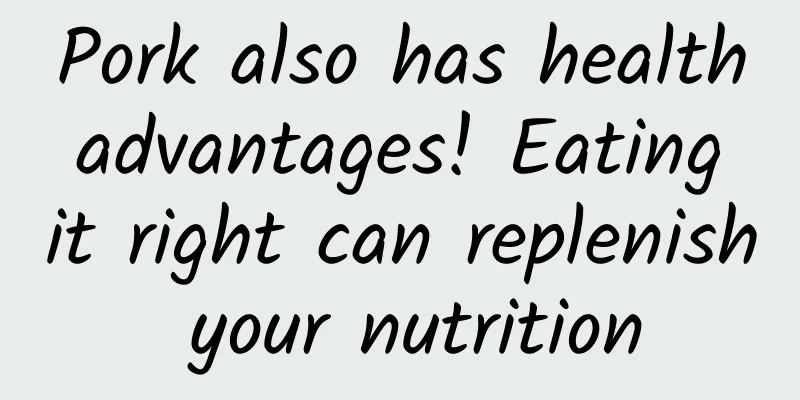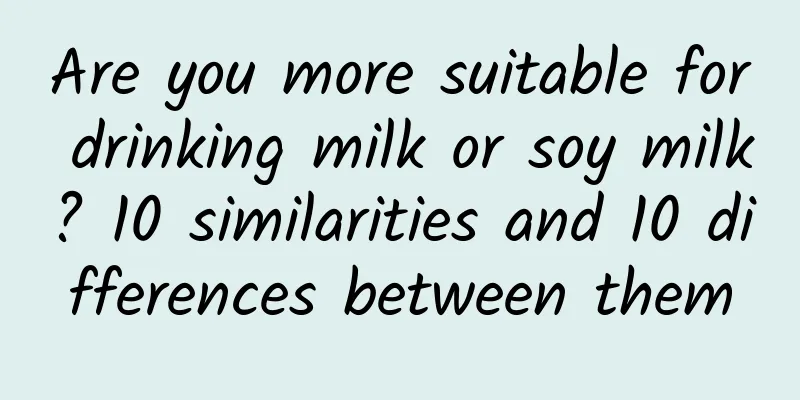Pork also has health advantages! Eating it right can replenish your nutrition

|
Many people believe that chicken and beef are healthy, but pork is low-grade and has low nutritional value. In fact, this is not necessarily true. If the ingredients are selected correctly, cooked correctly, and paired appropriately, pork is not only a food ingredient with good nutritional value, but can also make a significant contribution to a nutritious diet. Picture丨TuChong Creative Let’s talk about the protein in pork first. The belief that pork is low in protein means that the content in some parts of the pork is lower, not that all lean pork has low content. The protein content and fat content of meat are mutually exclusive. If there is more fat in a piece of meat, the protein content will inevitably be low. On the contrary, if there is less fat, the protein content will definitely not be low. The protein content of pure lean pork such as tenderloin and sirloin can reach 20%, which is the same level as beef and chicken. The protein content of skinless leg meat can also reach more than 18%. However, the protein content of pork belly is only about 10%, because the proportion of fat is too large, and even fat is accumulated in the gaps between lean meat fibers. The reason why pork neck is so popular is because it has a high fat content and is intertwined with lean meat and is difficult to distinguish, so its protein content is only 8%. The specific protein content depends on the breed of pigs and the degree of fattening, so it is impossible to generalize. Just like there are fattening chickens and free-range chickens; there are lean beef with high protein content and marbled beef with low protein content. In short, if you just want to supplement protein, there is no problem with eating lean pork, and you don’t have to eat only beef or chicken breast. Let’s talk about the fat in pork. Overall, the fat content of pork is higher than that of beef and mutton, but it also depends on different parts and different fattening methods, so it cannot be generalized. For example, the fat content of pork tenderloin and sirloin is only 6% to 8%, which is comparable to chicken thigh meat. The fat content of tender and delicious beef parts, such as top, sirloin, ribs, etc., is high enough, reaching 18% to 30%, which is higher than the skinless pork rump, pork knuckle, and pork leg. As for the fatty beef, fatty mutton, and marbled beef that have white fat visible to the eye, a layer of oil in the pan, and sizzling oil when fried, their fat content is astonishingly high, exceeding 30%, with no upper limit. The fatty acid composition of animal meat varies greatly depending on the feed and activity level. This is true for pork, beef, and chicken. The saturated fatty acid content ranges from 30% to 50%. In terms of fatty acid ratio, the fat in ordinary lean pork is roughly 40% saturated, 50% monounsaturated, and 10% polyunsaturated. Of course, if you feed it more green leafy vegetables and flax seeds, the polyunsaturated fatty acids will increase. As for beef and mutton, saturated fatty acids are higher and polyunsaturated fatty acids are lower. The specific ratio also depends on what kind of feed you eat and how much exercise you do. Therefore, from the perspective of fat content, lean pork is even better than fatty beef and fatty lamb. Then let’s talk about the vitamins in pork. Lean pork contains 8 B vitamins, among which vitamin B1 is particularly high, which is a great advantage. Whether it is beef, mutton, chicken, or duck, other meats are far behind pork in this indicator. (Pork has the genetic advantage of high vitamin B1, and the vitamin is abundant in feed.) According to my country's food composition table, the vitamin B1 content in 100 grams of lean pork is about 0.5 mg, while the content in lean beef, mutton and chicken is less than 0.1 mg. Some people may ask: What is the use of vitamin B1? What will happen if it is deficient? I asked. This vitamin is really worth taking more. Vitamin B1 is a super important co-factor in energy metabolism. It is necessary for muscle strength, heart function, brain activity, positive emotions... If you lack B1, you will feel tired without doing anything, depressed, slow thinking, muscle pain or numbness, abnormal heartbeat, heart enlargement, indigestion, edema, etc. In severe cases, it will be multiple neuritis. If you don't replenish vitamin B1 in time, you will lose your ability to work, and even in extreme cases, it may be fatal. The main sources of vitamin B1 are whole grains, beans, lean pork, milk, animal liver, kidney, heart and other internal organs, etc. Nuts and oil seeds such as peanuts and melon seeds also contain vitamin B1, but the significance is not so great, because the total amount of them eaten is not much, once eaten too much, the calories will exceed the standard. Unfortunately, the content of vitamin B1 in vegetables and fruits is not high. The largest share of vitamin B1 in the diet of most Chinese people comes from staple foods and pork. As mentioned earlier, other meats also contain this vitamin, but the content is much lower than lean pork. When I prepare a nutritious diet, if I don’t add some pork and there is no large proportion of whole grains and beans in the staple food, then there is almost no hope of meeting the vitamin B1 standard for the day. Vitamin B1 is the second most delicate vitamin among the B vitamins (the first is folic acid). It loses a lot during cooking, is particularly sensitive to alkali and high temperatures such as frying, and is easily lost in water. For example, when many people are frying or stewing meat, they often add alkali (compound meat tenderizers often contain edible alkali) to make the meat more tender and retain more water, which will significantly increase the loss of vitamin B1. When adding alkali to millet porridge or brown rice porridge, the porridge will be easier to cook and sticky, but the vitamin B1 will also be lost greatly. For example, peanuts contain a lot of vitamin B1, but fried peanuts cannot help us supplement B1. Over-roasted nuts and oil seeds will lose a lot of vitamin B1. When frying dough sticks, the vitamin B1 in the dough is almost completely killed. Therefore, eating fried foods will not only eat too much overheated bad fat, but also cause vitamin deficiency problems. For example, many people buy rice and grains that have been processed and dust and sand have been removed, but they insist on washing them several times, or even rubbing them hard, and the nutrients such as vitamin B1 on the surface of the grains are lost in the rice washing water. You should know that vitamin B1 mainly exists in the outer layer of grains. When it is ground into white rice and white flour, 80% of vitamin B1 has been lost. After washing and rubbing the rice hard, most of the remaining vitamin B1 is lost again. Because eating refined white rice is particularly prone to vitamin B1 deficiency, and the vitamin B1 content in vegetables and fruits is very low, rice with lean pork dishes is a reasonable combination. Chinese people who love to eat white rice also love to eat stewed pork and stir-fried shredded pork, which is a wise nutritional combination. Finally, let’s talk about the iron content in pork. Although pork, beef and mutton are all red meat, they have different degrees of "redness", and pork is the "whitest" of them. From a visual point of view, whether it is beef, mutton or donkey meat, the color of the meat is "redder" than lean pork. The red color of meat is closely related to the heme iron content in it. The color of pork is not as deep red because the heme iron content in it is significantly lower than that of beef and mutton, which are darker red, and is only slightly darker than chicken breast. For people who need iron supplementation, the higher the heme iron content, the better. But on the other hand, less heme iron is not necessarily a disadvantage. For people who do not have iron deficiency anemia, too high heme iron intake will promote inflammatory response, which is one of the important reasons why eating more red meat is not good for health. For example, people with high blood pressure, acne-prone people, people with inflamed wounds, people with boils on the skin, and people with bacterial infections are all advised to eat less beef and mutton. In comparison, eating lean pork is relatively safer. I remember a medical expert told me that she found that patients with wound infections became more seriously ill after eating mutton, but not significantly worse after eating pork. She believed that the traditional health care believed that pork was "neutral" and mutton was "hot", which might have something to do with the effect of promoting inflammatory response. However, although pork has its advantages, it also depends on how you choose and eat it. Let’s first talk about the differences between different parts. Many people discriminate against pork because it is high in calories. In fact, although pork belly is extremely high in calories, the calories of pure lean pork are not much higher than chicken legs. On a pig, the tenderloin and sirloin are usually the lowest in fat, and the hind and front rump are also lean meat after removing the fat. The elbow is also a good lean meat after removing the skin. However, people's favorite parts are always those with high fat, tender texture and strong aroma, such as pork belly, pork neck, spare ribs and even pork belly, fat lamb slices, fat beef slices, lamb chops, beef ribs, marbled beef... This is not the fault of the meat, but human taste and choice tend to these meats, so these fragrant meats are more expensive, and breeders are more willing to produce such meat. Therefore, the key is not what kind of animal meat you choose, but what part of the animal you choose and what kind of taste you want. Meat with high protein and low fat must be "dry". If you want it to be tender, juicy and fragrant, it can only be high-fat meat. Let’s talk about the influence of cooking methods. The calories in a dish depend largely on the cooking method. If you eat lean pork cooked with little oil, the calories are not that high; if you eat fried or stir-fried meat dishes, or meatballs with a lot of fat, the calories are bound to be high, and you can't blame the pork. Since you can eat boiled chicken breast, grilled chicken breast, and braised beef shank for health and low fat, why can't you eat grilled pork tenderloin and braised pork elbow (skinless)? In fact, you can also reduce the fat content of pork by cooking. For example, you can cook out some of the fat in the meat by stewing it, and then separate it out. You can also steam the fat out of the meat by steaming it with flour. In this way, the fat content of the meat is reduced. If you use a non-stick pan to fry lean meat slices, you don't actually need much oil, and the calories won't increase too much. The excess oil can be drained out and used to mix cold dishes or noodles, which are very fragrant. It should be noted that vegetable oil is suitable for frying meat. After all, half of the fat in pork is saturated fatty acids and less polyunsaturated fatty acids, so it is suitable to use oil rich in polyunsaturated fatty acids. The third thing to explain is the combination of pork and other ingredients. One of the great things about pork is that it can be cooked in a variety of ways and is suitable for mixing with a variety of ingredients. The dietary guidelines recommend that we eat 40-75 grams of meat per day (skinless, fat-free, boneless), which many people find unsatisfying. If you eat a large piece of meat directly, it is really just three or five pieces. But if you cut it into strips or slices and eat it with other ingredients, it is not too little, and you can get the joy of eating meat with a small amount of meat. Nowadays, supermarkets have pre-cut chilled lean meat shreds and slices, which are very convenient to buy and cook directly at home. First, stir-fry a bowl of shredded or sliced meat, divide it into two or three portions, and put it in the refrigerator or freezer. When cooking, you can take out a portion and stir-fry it with various vegetables. It is easy and delicious. This ensures that the total amount of meat in each meal is within a healthy range, while still allowing you to enjoy the aroma and taste of the meat. If you want to increase protein while eating less meat, there is another good way, which is to use pork with some dried tofu. For example, instead of making shredded pork with celery, you can now make shredded pork with shredded dried tofu and celery. Pork is rich in vitamin B1 but low in calcium; dried tofu is rich in calcium but low in vitamin B1. Both are good sources of protein. Stir-frying with shredded meat and shredded tofu in a one-to-one ratio not only gets the aroma of meat, but also adds rich calcium and plant protein from soy products. The price of pork has been falling recently and has reached a level that is affordable to the public. Compared with beef and mutton, the price is much cheaper. Taking this opportunity, why not eat some lean pork regularly to supplement vitamin B1? Data source: Yang Yuexin, ed., Chinese Food Composition Table (Standard Edition), Peking University Medical Press, 2019; USDA Food Composition Database Reprint/ Cooperation please contact Source: Fan Zhihong_Original Nutrition Information The pictures are copyrighted and reproduction of the contents is not authorized. |
<<: The paints are not only colorful, but some are also very "heavy"
>>: It is a "time bomb" in the body! Staying up late, not exercising, and smoking are all causes
Recommend
If you want to lose 10 pounds before summer, start eating like this now!
As the temperature rises day by day, everyone'...
African kids wish North Korea happy birthday video
A simple small blackboard with words written on i...
Is online and offline integration the mainstream strategy for community marketing?
Due to the increasingly fierce competition in tra...
The road to Shu is harder than ascending to heaven: Which road exactly is the road to Shu?
The road to Shu is as difficult as ascending to h...
Why are women more prone to constipation than men? 5 ways to help you!
There are many differences between men and women,...
The marketing logic behind Yuanqi Forest’s “brand identity”
Genki Forest changed its logo, changing the Japan...
Why does rhinitis get worse in winter in the north?
Speaking of rhinitis, it is estimated that many p...
Advertising material design guide!
Advertising materials should be designed accordin...
Analysis of 7 short video channels including Taobao and Video Account!
Douyin, Kuaishou, Xiaohongshu, Taobao, Video Acco...
He died of influenza A and influenza B at the age of 41! Why can you get influenza B after getting influenza A?
On February 15, the official website of New Weekl...
Tencent advertising skills and common problems!
This article shares with you some difficult probl...
Is your appearance plummeting? Maybe you have this disease.
Is your appearance plummeting? Maybe you have thi...
Whole wheat bread mixed with "bran" in the flour? Experts: Bran and bran are not the same substance
"Wholemeal bread is made by mixing bran, als...
How to improve product user activity and retention through UGC design?
This article will start with five discussion poin...
How did the website Jiuyuequan4 do it? How much does the website cost?
To judge the ranking ability of a website, weight...









